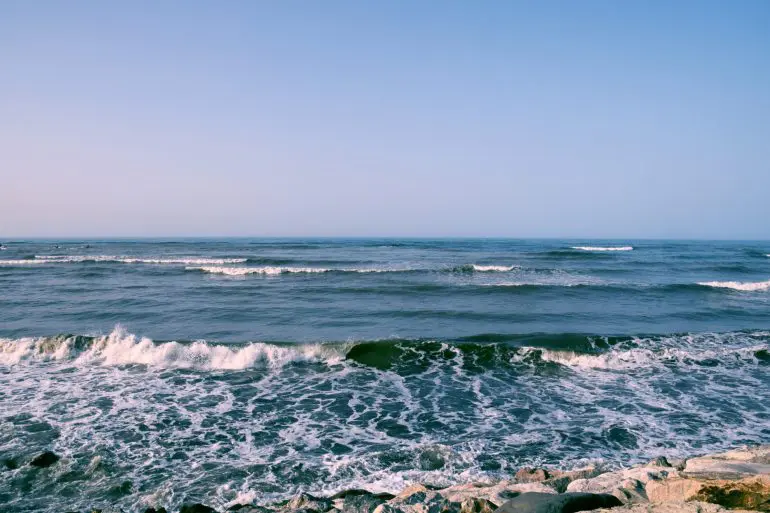Lakes are an incredibly diverse geological feature. They’re found on every continent and in extreme climates and elevations, each with their own unique ecosystems. Some lakes are large and deep, while others are small and shallow. Some lakes are freshwater, while others are saltwater. And, while there’s no international definition of a lake, their main defining feature is that they are bodies of water surrounded by land.
In terms of ranking the largest lakes in the world, these differences come to the fore. Because size can be defined by numerous metrics, from volume of water to coastline area. In this article, we’re looking at the biggest lakes in the world in terms of surface area. And we’re starting with the world’s largest lake.
Caspian Sea

Scenic view of Caspian sea against clear sky (Photo: Zahra Momeni / EyeEm via Getty Images)
For the biggest lake on the planet, head to the Caspian Sea. Covering an area of around 143,000 square miles and containing some 40 percent of the world’s lacustrine – or lake – water, it lies between Asia and Europe. The north of the Caspian is bordered by Russia, the west by Azerbaijan, the south by Iran, to the southeast is Turkmenistan and the northeast coast is in Kazakhstan.
Now, you may be wondering why a ‘sea’ is included in this list of lakes. In fact, there are valid arguments for categorising the Caspian as either. And, without any formal international definitions of lakes or seas, it’s up for debate. It was almost certainly once connected to the open ocean until around 11 million years ago and is partially saltwater. Nevertheless, the academic community has it as a lake, primarily due to the fact that it is entirely enclosed by land.
Lake Superior

The coast of Lake Superior, near Grand Marais, Minnesota (Photo: Matt Anderson Photography via Getty Images)
The second in line of the largest lakes in the world is sandwiched between Canada and the United States. Lake Superior covers an area of 31,700 square miles, and is bordered by the city of Ontario and the states of Michigan, Wisconsin and Minnesota. Unlike the Caspian Sea, Lake Superior is entirely a freshwater body, rendering it the largest freshwater lake in the world.
It’s also fresh in terms of age, being just 10,000 or so years old. Compare that to the Caspian’s 11 million and it’s practically a baby. It’s also one of the five Great Lakes of North America.
Lake Victoria

A moored boat against the sunset on Lake Victoria, Tanzania (Photo: MattiaATH via Getty Images)
Bordered by Uganda, Kenya and Tanzania, Lake Victoria takes the third spot on the list of the largest lakes in the world with an area of 26,590 square miles. For context, that’s roughly the size of the nation of Georgia. One of the African Great Lakes, it’s also the biggest lake in Africa and is home to around 200 species of fish.
Lake Huron

Lake Huron, Ontario (Photo: Posnov via Getty Images)
Covering some 23,007 square miles, Lake Huron is the second largest of the Great American Lakes on this list after Superior. Conversely, it’s both the deepest and most voluminous of the Great Lakes of North America, with a maximum drop of 750 feet and containing 850 cubic miles of water.
Bordered by the Canadian province of Ontario and the state of Michigan to the south, the lake is approximately 325 miles long and 120 miles across at its widest point. It’s renowned for its many shipwrecks, believed to number around 1,000.
Lake Michigan

Lake Michigan, Sawyer, Michigan (Photo: Single-Tooth Productions via Getty Images)
Linked to Huron via the Straits of Mackinac, Lake Michigan is surrounded by Illinois, Indiana, Wisconsin and, of course, Michigan. It’s unique as the only American Great Lake entirely within the borders of the United States.
Lake Michigan’s surface area of 58,000 square miles earns it the title of fourth largest lake in the world, but also that of the largest lake contained within one country. The lake’s name is derived from the Ojibwe word mishigami, meaning “large lake”.
Lake Tanganyika

Lake Tanganyika, Northern Province, Zambia (Photo:
Most of Lake Tanganyika is located within Tanzania and the Democratic Republic of Congo, with the rest in Burundi, and Zambia. It’s the deepest lake in Africa and the second-deepest lake in the world, after Lake Baikal. Tanganyika is also the longest freshwater lake in the world, measuring about 676 km in length.
One feature for which Tanganyika is renowned is its incredible biodiversity. In addition to its eight species of crab, 15 species of shrimp, and around 60 snail species, the lake is famed for its resident cichlid fish. It is said that there are over 250 cichlid species within the lake. Extraordinarily, many of the species are endemic, meaning they cannot be found anywhere else.
The Biggest Lakes on the Planet

The beauty of Lake Superior (Photo: Star Tribune via Getty Images / Contributor via Getty Images)
And so, we’ve explored the largest lakes in the world and found not only the world’s largest lake, but that it’s not the same as the largest freshwater lake in the world. Along the way, we touched on the murkiness of defining what a lake is and that there’s a question as to whether the biggest lake on the planet is in fact a sea.











